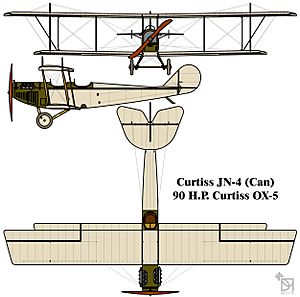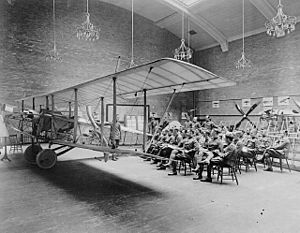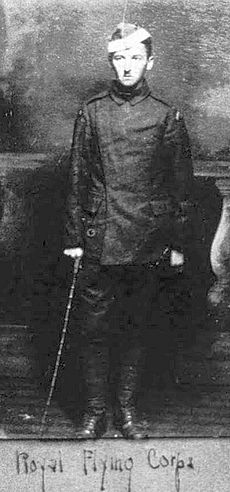Royal Flying Corps Canada facts for kids
Quick facts for kids Royal Flying Corps Canada |
|
|---|---|
 |
|
| Active | 1917–1919 |
| Country | Canada |
| Allegiance | United Kingdom |
| Type | Air force |
| Role | Military Aviation Training |
| Engagements | World War I |
| Commanders | |
| General Officer Commanding | Brigadier-General Cuthbert Hoare |
| Aircraft flown | |
| Trainer | Curtiss JN-4 (Can) "Canuck" |
The Royal Flying Corps Canada (RFC Canada) was a special training group. It was part of the British Royal Flying Corps during World War I. This group helped train pilots and aircrew in Canada. It started its important work in 1917.
Contents
Why Canada Became a Training Hub


As World War I continued, Great Britain needed many more pilots. They also needed more places to train them. Some training happened at the Curtiss Aviation School. This school was in Long Branch near Toronto. It trained pilots for land planes. Another school at Hanlan's Point on Toronto Island trained pilots for flying boats. Training also took place in the United States.
Many Canadians and Americans wanted to join British flying groups. So, it made sense to open British air training bases in Canada. Canada also had lots of open space for these large facilities.
Training Bases Across Ontario
After talking with the Canadian government, the RFC started its operations. Lieutenant-Colonel Cuthbert Hoare led the RFC in Canada. He later became a Brigadier-General. Several training bases opened in southern Ontario.
The main training site was at Camp Borden. Other bases were in Beamsville and Hamilton. Hamilton had a special school for weapons. North Toronto had bases at Armour Heights, Leaside, and Long Branch. Armour Heights had a "School of Special Flying." More bases were in Deseronto (Mohawk and Rathburn).
The JN-4 (Canadian) plane, also called the Canuck, was used for training. The RFC ordered 500 Avro 504K planes. But only one was finished in Canada before the war ended in November 1918. This plane was not used for training.
Working with the United States
Brigadier-General Hoare made deals with US Brigadier-General George Owen Squier. Squier was in charge of the US Army’s air service. The US Army needed more flight instructors. The RFC let five experienced American pilots go to the US Army. These pilots became leaders of squadrons.
The US also allowed the British to open a recruiting office in New York City. This office was supposed to sign up British citizens. But it also signed up about 300 US citizens. The RFC also trained many US Army flight staff. This included 400 pilots, 2,000 ground crew members, and 20 equipment officers. These Americans would then get planes and equipment from the UK. After that, they would join the RFC in France.
Ten American squadrons trained in Canada during the summer of 1917. In return, RFC squadrons were allowed to train during the winter in Fort Worth, Texas.
Becoming the Royal Air Force Canada
In April 1918, the Royal Flying Corps changed its name. It became the Royal Air Force. Because of this, the unit in Canada became known as Royal Air Force Canada.
During the last two years of the war, 3,135 pilots and 137 observers trained in Canada and Texas. They trained for both the RFC and the new Royal Air Force (RAF). Out of these trainees, 2,624 went to Europe for active duty.


